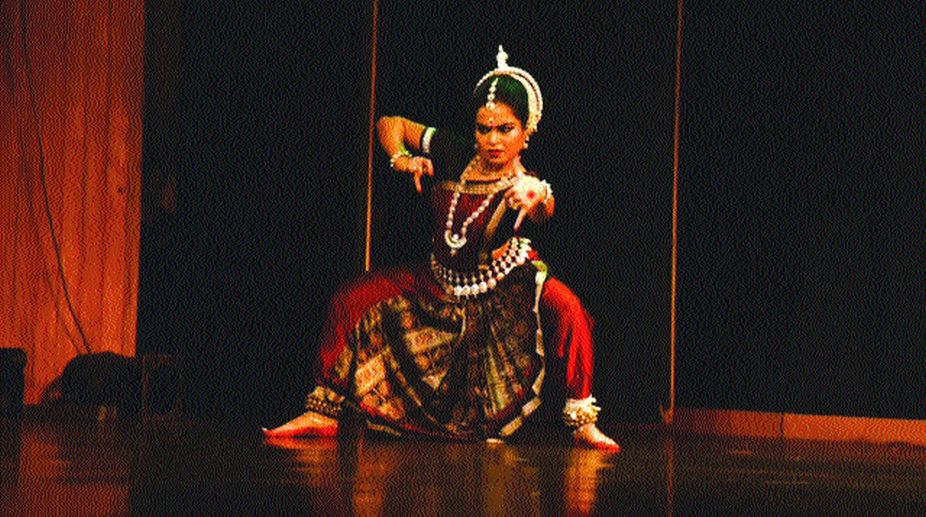Srjan, the premier dance institute established in Bhubaneswar by the legendary Guru Kelucharan Mohapatra in the year 1993, is keeping up with its high standards of creativity and performance after the Guru's demise, under the able guidance of Ratikant Mohapatra, the gifted son and disciple of the late Guru, who is nurturing the reputed institute with his dedicated efforts to carry forward the legacy and to preserve and propagate the rich cultural heritage of Odisha, especially its performing arts. Apart from the various festivals he holds in Bhubaneswar in memory of the late Guru, Antardrishti has been conceptualised to be presented in the Capital, as a tribute to the great Guru on his birth anniversary. The music and dance lovers of Delhi witnessed solo and group choreographies of the late Guru and the present Pracharya Ratikant during Antardrishti, the two-day festival that marked the 91st Birth Anniversary of Guru Kelucharan Mohapatra, at the Stein Auditorium of the India Habitat Centre this past week.
The concluding evening of Antardrishti showcased the talented Odissi danseuse Rajshree Praharaj in Seeta Haran, a solo treat in Odissi dance style, based on the Ramacharitamanasa of Goswami Tulsidas. The versatile dancer captivated the audience with her Ekaharya Abhinaya, enacting multiple characters of Ramayana, depicting that section of the story when during the 14 year exile, or Vanavasa, Rama, Laxman and Seeta were living in Panchavati, where Marich comes in a disguise of the Swarna Mriga, the golden deer. Enamoured by its beauty Seeta requests Rama to get her the golden deer and sends Laxman to take care of Rama. Ravana, the demon king, making full use of the conspired opportunity asks Seeta for alms disguised as a beggar. The moment she crosses the "Lakshman Rekha", he kidnaps her.
It was amazing to see Rajshree enacting so many different roles with contradictory shades of emotions, with such perfection. If her command on the Odissi technique enabled her to follow the thoughtfully-conceived immortal choreography of Guru Kelucharan Mohapatra flawlessly, her gift of emotive expressions brought out the nuances of the Rasa-Bhava in its essence.
Advertisement
The second item was Namami Gange, a group choreography by Guru Ratikanta Mohapatra in Odissi dance style, based on the story of river Ganga from Gangavataran ~ the story of her origin, how Maharaja Sagar and his sons lost their lives and how king Bhagirath did penance to bring Ganga to earth so that he could do proper cremation of his Purvajas, or ancestors. The king prayed to Lord Shiva to hold the unbearable force of the mighty river so that it can descend on this earth. Then the journey of Ganga from Gangotri to the Bay of Bengal, passing through Hrishikesh, Varanasi, Prayag Raj and Sangam et al… How the people on earth have ill-treated the holy river, maligning her waters and the efforts to clean the waters were all depicted in a seamless way, in the imaginative choreography that had picturesque freezes and lovely tableaux, like the realistic scene of Manikarnika Ghat, in Varanasi, showing the "Shava-yatra" for instance. Even the music was very thoughtfully composed, from the opening invocatory Sanskrit shlokas to Ganga Aarti at Hrishikesh et al.
The inaugural evening saw a few immortal choreographies of Srjan in Ardhanareeshwara, Samakala, Vithala Smarane, Vishwas and Vande Mataram. The Ardhanareeshwara was based on the Sanskrit stotra of Shankaracharya, where the depiction of Shiva and Shakti complement each other in Tandava and the Lasya Ang in "Namah Shivaya cha namah Shivayai…", invoking both in the last line of each Shloka. The music is composed by Raghunath Panigrahi, who has very imaginatively used different Ragas and Talas to enhance the Sahitya, in Raga-Malika and Tala-Malika. Samakala underlined the technical aspect of Odissi whereas Vithala Smarane and Vande Mataram were imbued in Bhakti Rasa for Lord Vithala and the Motherland. No wonder the jampacked hall offered standing ovations on both the evenings.
Advertisement











